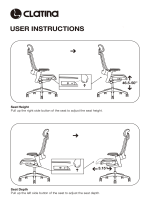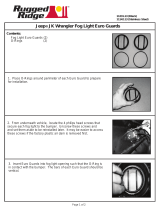Page is loading ...

Technical�training.
Product�information.
BMW�Service
F11�Body.

General�notes
Symbols�used
The�following�symbol/pictograph�is�used�in�this�document�for�better�understanding�or�to�emphasize
particularly�important�information:
Contains�important�safety�tips�and�information�required�for�proper�system�function,�which�must�be
observed�under�all�circumstances.
Topicality�and�national�versions
BMW�Group�vehicles�are�designed�to�meet�the�highest�safety�and�quality�requirements.�Changing
requirements�in�areas�such�as�environmental�protection,�customer�benefit,�design�and�construction
lead�to�continuous�advancement�of�systems�and�components.�This�can�result�in�deviations�between
the�information�contained�in�this�document�and�the�vehicles�available�for�training.
This�document�describes�European�version�vehicles�with�left-hand�drive�as�a�matter�of�principle.�In
vehicles�with�right-hand�drive�some�controls�and�components�may�be�arranged�differently�than�shown
in�the�illustrations�in�this�document.�Other�deviations�may�result�from�equipment�versions�for�specific
markets�or�countries.
Additional�information�sources
Further�information�on�the�individual�subjects�is�given:
• in�the�operating�instructions
• in�the�Integrated�Service�Technical�Application:
Contact:�conceptinfo@bmw.de
©2010�BMW�AG,�Munich
Reproduction,�in�whole�or�in�part,�is�permissible�only�with�written�approval�of�BMW�AG,
Munich.
The�information�contained�in�this�document�is�a�part�of�the�BMW�Group�Technical�Training�Program
and�is�intended�for�trainers�and�participants�in�this�program.�Changes/supplements�to�the�technical
data�are�given�in�the�current�BMW�Group�information�system.
Information�status:�June�2010
VH-23/International�Technical�Training

F11�Body.
Contents
1. Introduction............................................................................................................................................................................................................................................5
1.1. The�new�BMW�5�Series�Touring.................................................................................................................................................. 5
1.1.1. Dimensions.....................................................................................................................................................................................5
1.1.2. Silhouette�comparison.................................................................................................................................................7
2. Body......................................................................................................................................................................................................................................................................8
2.1. Body�shell.......................................................................................................................................................................................................................... 8
2.1.1. Introduction....................................................................................................................................................................................8
2.1.2. Materials..............................................................................................................................................................................................9
2.1.3. Corrosion�protection�and�sealing........................................................................................................... 11
2.1.4. Front�end.......................................................................................................................................................................................13
2.1.5. Side�frame................................................................................................................................................................................... 14
2.1.6. Roof........................................................................................................................................................................................................14
2.1.7. Rear�end......................................................................................................................................................................................... 15
2.1.8. Rear�panel....................................................................................................................................................................................16
2.2. Pedestrian�protection..................................................................................................................................................................................16
2.2.1. Active�engine�hood....................................................................................................................................................... 16
2.3. Doors..................................................................................................................................................................................................................................... 18
2.4. Rear�hatch.....................................................................................................................................................................................................................20
2.4.1. Rear�hatch�operating�concept..................................................................................................................... 22
2.4.2. Hear�window�operating�concept..............................................................................................................22
2.5. Panorama�glass�roof..................................................................................................................................................................................... 22
2.5.1. Dimensions................................................................................................................................................................................ 24
2.6. Strength............................................................................................................................................................................................................................ 24
2.7. Accident�research.............................................................................................................................................................................................26
2.7.1. Preventative�measures............................................................................................................................................ 26
2.7.2. Safety�tests/accident�analysis......................................................................................................................28
2.7.3. Head-on�collisions..........................................................................................................................................................29
2.7.4. Side�collision........................................................................................................................................................................... 30
2.7.5. Rear�end�collision............................................................................................................................................................ 33
2.7.6. Pedestrian�protection................................................................................................................................................ 34
3. Exterior�and�interior�equipment................................................................................................................................................................... 36
3.1. Exterior�equipment..........................................................................................................................................................................................36
3.1.1. Front�end.......................................................................................................................................................................................36
3.1.2. Rear�bumper............................................................................................................................................................................ 37
3.1.3. Roof�railing.................................................................................................................................................................................. 37
3.1.4. Underbody�concept..................................................................................................................................................... 37
3.2. Interior�equipment............................................................................................................................................................................................38
3.2.1. Dimensions................................................................................................................................................................................ 38
3.2.2. Instrument�panel............................................................................................................................................................... 38

F11�Body.
Contents
3.2.3. Center�console:...................................................................................................................................................................41
3.2.4. Front�storage�features..............................................................................................................................................42
3.2.5. Rear�storage�features................................................................................................................................................ 44
3.2.6. Front�seats..................................................................................................................................................................................45
3.2.7. Rear�seats.................................................................................................................................................................................... 51
3.2.8. Air�conditioning................................................................................................................................................................... 53
3.3. Luggage�compartment............................................................................................................................................................................. 55
3.3.1. Luggage�compartment�roll-up�cover................................................................................................57
3.3.2. Dimensions................................................................................................................................................................................ 59

F11�Body.
1.�Introduction.
5
1.1.�The�new�BMW�5�Series�Touring.
The�F11�will�be�introduced�on�the�market�in�September�2010.�The�models�523i�and�535i�will�be
offered�with�gasoline�engine.�Models�520d�and�350d�will�be�equipped�with�diesel�engines.
BMW�5�Series�Touring
1.1.1.�Dimensions
BMW�5�Series�Touring,�outer�dimensions
Index Explanation Value
a
Vehicle�height,�unladen
1
[mm] 1462
b Track,�front,�with�basic�wheels [mm] 1600
c Front�overhang [mm] 832
d Wheelbase [mm] 2968
e Rear�overhang [mm] 1107

F11�Body.
1.�Introduction.
6
Index Explanation Value
f Track,�rear,�with�basic�wheels [mm] 1626
g Vehicle�length [mm] 4907
h Vehicle�width�not�including�exterior�rear�view
mirrors.
[mm] 1860
1
�With�roof�antenna.�1488�mm
Comparison�F10/F11/E61
F10 F11 E61
Vehicle�height,�unladen [mm] 1464
1462
1
1491
Track,�front [mm] 1600 1600 1558
Front�overhang [mm] 832 832 852
Wheelbase [mm] 2968 2968 2886
Rear�overhang [mm] 1099 1107 1105
Track,�rear [mm] 1627 1626 1581
Vehicle�length [mm] 4899 4907 4843
Vehicle�width�not�including�exterior�rear�view
mirrors.
[mm] 1860 1860 1846
Vehicle�width�including�exterior�rear�view�mirrors. [mm] 2094 2093 2030
Turning�circle�(unladen) [m] 11.95 11.95 11.4
Front�shoulder�room [mm] 1480 1480 1456
Rear�shoulder�room [mm] 1427 1427 1454
Front�elbow�room [mm] 1518 1518 1484
Front�elbow�room [mm] 1485 1486 1496
Maximum�front�head�room [mm] 1028 1028 1027
Maximum�rear�head�room [mm] 973 993 994
Luggage�compartment�volume [liters] 520 560–1670 500–1650
1
�With�roof�antenna.�1488�mm
Weights�and�payload
Weights�in�compliance�with�DIN�for�F11�and�E71,�European�version�and�payloads�are�given�in�the�table
below:

F11�Body.
1.�Introduction.
7
Vehicle Curb�weight�(DIN)
Automatic�/�manual�transmission
Payload
F11�523i [kg] 1730�/�1715 650
E61�525i [kg] 1630�/�1605 600
F11�535i [kg] 1770�/�1765 650
E61�530i [kg] 1630�/�1620 600
F11�520d [kg] 1715�/�1710 650
E61�520d [kg] 1620�/�1600 600
F11�530d [kg] 1805�/�1800 650
E61�530d [kg] 1700�/�1660 600
1.1.2.�Silhouette�comparison
F11�Silhouette�comparison�with�BMW�5�Series�Touring�E61

F11�Body.
2.�Body.
8
2.1.�Body�shell
F11�Body�shell
2.1.1.�Introduction
On�the�F11�great�value�was�also�placed�on�light�weight�construction.�This�was�implemented�by
intelligent�use�of�high�strength�multi-phase�steels�and�high�strength�hot�formed�steels.�On�the�F11�the
average�strength�of�the�body�materials�has�increased�by�37�%�in�comparison�to�the�E61.
The�light�weight�material�significantly�reduces�the�vehicle�weight�and,�in�combination�with�a�stiff�body
skeleton,�provides�a�considerable�contribution�to:
• Driving�stability
• Fuel�economy
• Reduction�of�CO
2
emissions
• Passive�safety.

F11�Body.
2.�Body.
9
Highlights
• Cast�aluminum�suspension�strut�dome
• High�percentage�of�multi-phase�steels�(20%�of�weight�of�body�skeleton).
• High�percentage�of�hot�formed�steels�(9�%�of�weight�of�body�skeleton).
The�load-optimized�component�design�of�the�cast�aluminum�suspension�strut�domes�reinforces
the�front�end.�In�comparison�to�conventional�steel�shell�design,�the�compact�design�has�significantly
reduced�the�space�requirements�and�decreased�the�weight�in�the�front�end.�This�has�led,�among�other
things,�to�more�uniform�axle�load�distribution.
The�high�strength�multi-phase�steels�and�high�strength�hot�formed�steels�ensure�low�weight�while
providing�maximum�strength�for�the�passenger�safety�cell�thus�contributing�to�the�passive�safety�to�a
high�degree.
An�innovative�advancement�in�the�form�of�passive�corrosion�protection�is�used�on�the�hot�formed
steels.�Until�now�suitable�hot�formed�sheet�metal�materials�with�cathodic�corrosion�protection�were
not�available�on�the�market.�Development�of�press�hardening�technology�has�provided�a�mass
production�process�for�production�of�galvanized,�hot�formed�components.
With�this�process�galvanized�sheet�metal�is�first�cold�formed�and�then�heated�to�a�temperature�of
approx.�900�°C.�Immediately�thereafter�the�components�are�cooled�down�to�approx.�70°C�within
seconds�directly�in�the�water�cooled�pressing�tools,�hardening�the�components.�This�process
produces�components�with�a�minimum�yield�strength�significantly�greater�than�1000�MPa.
Components�produced�in�this�manner�can�be�used�in�wet�areas�without�any�corrosion�to�the�base
material.�Additional�corrosion�protection�measures�are�eliminated�for�such�steel.
2.1.2.�Materials
Modern�automotive�bodies�must�satisfy�many�requirements.�In�spite�of�minimum�outer�dimensions
they�must�provide�the�largest�possible�interior�space.�Passengers�must�be�protected�optimally�against
injury�in�the�event�of�an�accident.�The�torque�generated�by�all�assemblies�such�as�the�engine�and
transmission�is�supported�by�the�body.�Moreover�the�body�must�provide�high�static�and,�above�all,
dynamic�rigidity�to�guarantee�the�exceptional�driving�characteristics�typical�for�BMW.
Last,�but�not�least,�the�supporting�structure�of�the�vehicle�must�have�high�fatigue�strength�and�be
capable�of�repair�at�reasonable�expense�in�the�event�of�an�accident.
To�satisfy�all�of�these�requirements�optimally,�BMW�pursues�a�strategy�of�producing�every�component
using�the�material�best�suited�for�the�specific�function.
The�two�terms,�aluminum�and�steel,�are�only�the�generic�terms�for�a�variety�of�alloys�with�highly
differing�properties.

F11�Body.
2.�Body.
10
F11�Body�shell�materials
Index Explanation
1 Multi-phase�steels�(>�300�MPa)
2 Hot�formed�steels�(>�900�MPa)
3 Aluminum
4 Other�steels�(>�300�MPa)
Multi-phase�steels�are�steels,�whose�structure�consists�of�a�number�of�phases.�High�strength�multi-
phase�steels�with�a�yield�strength,�R
p0.2,
�between�300�and�600�MPa�include,�for�example,�dual-phase
steels�or�TRIP�steels.�High�strength�multi-phase�steels�with�a�yield�strength,�R
p0.2,
�greater�than�600
MPa�include,�for�example,�complex�steels�or�martensite�phase�steels
Hot�formed�manganese-boron�steels�are�high�strength�steels�with�a�yield�strength,�R
p0.2,
�greater�than
900�MPa.
Percentages�by�weight
The�percentage�of�high�and�maximum�strength�multi-phase�steel,�high�strength�hot�formed�steel�and
aluminum�is�increasing�to�reduce�vehicle�weight�while�simultaneously�guaranteeing�maximum�body
strength.

F11�Body.
2.�Body.
11
F11�Body�shell,�distribution�of�materials
Index Explanation
1 Multi-phase�steels�(>�300�MPa)�Percentage�20%
2 Hot�formed�steels�(>�900�MPa)�Percentage�9%
3 Aluminum,�Percentage�2%
4 Other�steels�(<�300�MPa)�Percentage�69�%
2.1.3.�Corrosion�protection�and�sealing
Galvanized�sheet�metal�and�aluminum�or�aluminum�sandwich�panels�are�used�primarily�on�the�F11
body�to�optimize�corrosion�protection.�Joining�technologies�include�welding,�gluing�and�riveting.
Sheet�metal�overlaps�are�laid�out�to�minimize�abutting�surfaces.�This�helps�prevent�creep�corrosion.
The�body�structure�is�designed�to�prevent�water�penetration�by�gluing�and�sealing�the�joined�surfaces.
In�particularly�critical�areas,�expanded�foam�parts�are�used�to�seal�hollow�cavities�in�the�body�against
moisture.�Double�layers�of�sheet�metal�in�wet�areas�are�double�sealed,�and,�if�necessary,�preserved
additionally�with�wax.

F11�Body.
2.�Body.
12
Overlapping�layers�of�sheet�metal�in�dry�areas�are�sealed�where�necessary�to�prevent�dust�from
entering.
Contact�is�avoided.�between�different�types�of�materials,�which�are�critical�in�terms�of�corrosion.�The
combination�of�material�substrates�and�joining�procedures�is�matched�carefully�to�prevent�corrosion
risks.
Coating�process
During�the�painting�process�the�body�shell�is�immersed
• in�an�alkaline�bath�for�cleaning
• phosphated�(surface�roughened�up�for�better�adhesion)
• coated�using�a�catalytic�immersion�process�(coated�with�corrosion�protection�paint�on�inside
of�all�hollow�body�cavities).
The�organic�finish�paint�is�then�baked�on.
Moreover�the�body�is�sealed�with�PVC�and�the�outer�surface�protected�with�filler,�top�coat�and
transparent�paint.
Particularly�critical�body�areas�on�the�F11�are�protected�by�systematic�hollow�cavity�preservation.
The�objectives�are:
• Five�years�without�any�visible�corrosion�to�the�body�surface
• Three�years�without�any�visible�corrosion�in�the�underbody�area
• Twelve�years�without�any�panels�rusting�through
• Seal�against�water�and�dust

F11�Body.
2.�Body.
13
2.1.4.�Front�end
F11�Front�end
Index Explanation
1 Right�rear�strut
2 Left�rear�strut
3 Left�front�strut
4 Right�front�strut
Aways�observe�the�repair�instructions�when�removing�or�installing�struts.
The�struts�increase�the�rigidity�of�the�front�end.
Repair�to�the�front�end�does�not�present�any�grave�differences�in�comparison�to�the�F10.

F11�Body.
2.�Body.
14
2.1.5.�Side�frame
F11�Separation�points�for�repair
The�separation�points�shown�above�should�be�used�preferably�for�repair.
F11�Replacement�part�sections
The�rear�side�panel�is�welded�to�the�body�shell�at�the�factory.�When�repairing�the�rear�side�panel�can�be
glued�and�riveted.
2.1.6.�Roof
The�roof�is�welded�to�the�body�shell�at�the�factory.�When�repairing�the�roof�can�be�glued�and�riveted.

F11�Body.
2.�Body.
15
2.1.7.�Rear�end
F11�Rear�end
Repair�to�the�rear�end�does�not�present�any�grave�differences�in�comparison�to�the�F01.

F11�Body.
2.�Body.
16
2.1.8.�Rear�panel
Rear�panel
The�rear�panel�is�welded�to�the�body�shell�at�the�factory.�When�repairing�the�rear�panel�can�be�glued
and�riveted.
2.2.�Pedestrian�protection
A�number�of�pedestrian�protection�features�are�installed�on�the�front�end�of�the�F11.�A�shock�absorber
is�installed�between�the�bumper�support�and�bumper�trim�to�protect�against�leg�impact.�The�engine
hood�and�front�side�panels�are�made�of�aluminum�and�equipped�with�deformation�elements.�This
design�is�intended�to�absorb�the�energy�in�a�defined�manner�in�the�event�of�an�accident.
2.2.1.�Active�engine�hood
An�active�engine�hood�is�installed�depending�on�the�national�version.�In�the�event�of�a�collision�with�a
pedestrian,�the�hood�lifts.�This�provides�a�deformation�zone�to�protect�the�pedestrian.
When�working�on�engine�hood�hinges�and�engine�hood�latches�observe�the�repair�instructions.
Otherwise�unintended�actuation�could�pose�an�injury�hazard.

F11�Body.
2.�Body.
17
F11�Active�engine�hood
Index Explanation
1 Right�engine�hood�latch�(with�actuator)
2 Left�engine�hood�latch�(with�actuator)
3 Bowden�cable
4 Left�engine�hood�hinge�(with�actuator)
5 Right�engine�hood�hinge�(with�actuator)
6 Fiber�optic�cable
7 Actuator�(on�engine�hood�hinge)
8 Sensor
9 Interference�structure
A�fiber�optic�cable�is�integrated�between�the�bumper�support�and�the�shock�absorber.�The�fiber�optic
cable�is�connected�to�a�sensor�and�runs�back�to�the�sensor�over�a�loop�on�the�opposite�side�of�the
vehicle.

F11�Body.
2.�Body.
18
The�force�acting�on�the�fiber�optic�cable�causes�it�to�deform�between�the�interference�structures.
This�attenuates�the�light�conducted�by�the�fiber�optic�cable.�The�effective�force�is�proportional�to�the
attenuation�of�the�light.�The�different�attenuation�of�the�light�depending�on�the�mass�and�rigidity�of�the
colliding�object�generates�a�characteristic�signal.
This�signal�is�measured�by�the�sensor�and�transferred�to�the�ACMS�crash�safety�module�over�a�data
line.�The�ACMS�crash�safety�module�determines�from�this�data,�whether�the�threshold�for�recognition
of�a�collision�with�a�pedestrian�has�been�reached�or�exceeded�thereby�allowing�a�decision�to�be�made
to�activate�the�actuators�on�the�engine�hood.
The�actuators�are�activated�by�pyrotechnic�devices�raising�the�engine�hood�using�the�spring�force�of
the�integrated,�pretensioned�springs.
The�active�engine�hood�is�activated�only�at�speeds�of�approx.�20�-�50�km/h.�For�safety�reasons�the
system�may,�in�rare�cases,�activate�even�when�a�collision�with�a�pedestrian�cannot�be�clearly�excluded,
e.g.:
• Impact�with�a�barrel�or�marking�post
• Collision�with�animals
• Stone�impact
• Driving�into�a�snow�drift.
After�actuation�of�the�active�engine�hood�a�red�warning�triangle�illuminates�in�the�instrument�cluster
and�a�check�control�message�appears�in�the�central�information�display.�The�engine�hood�can�then�be
moved�back�to�its�initial�position,�however�the�active�pedestrian�protection�is�again�available�only�after
component�replacement.
Returning�engine�hood�to�initial�position
• Pull�engine�hood�lever
• Press�release�lever�and�open�engine�hood
• Open�engine�hood�all�the�way�to�the�end�position.
The�actuators�on�the�engine�hood�hinges�should�close�and�lock�completely.
• Move�engine�hood�back�and�drop�from�height�of�approx.�40cm;�press�to�lock�completely.
The�engine�hood�should�catch�audibly�on�both�sides.
2.3.�Doors
As�on�the�F01,�the�doors�installed�on�the�F11�consist�of�an�aluminum�shell�construction.

F11�Body.
2.�Body.
19
F11�Front�and�rear�doors
F11�Aluminum�shell�door�structure
Large�aluminum�shells�capable�of�transferring�high�forces�in�area�of�the�door�structure�guarantee
maximum�rigidity�and�component�quality�with�minimum�tolerances.�Realization�of�a�high�drawing
depth�and�new�component�separation�points�(hinge�reinforcement�and�inner�door�panel)�allow
implementation�of�the�attractive�design�on�the�exterior.
The�window�frame�area�satisfies�the�highest�demands�for�rigidity�using�channels�consisting�of�only
two�sheet�metal�parts�with�minimum�dimensions�and�simultaneous�production�efficiency.�BMW�has
succeeded�in�implementing�its�typical�exterior�appearance�even�in�the�visually�sensitive�area�of�the
window�frame.
Advantages:
• Reduced�CO
2
emissions�and�increased�stability�through�weight�reduction.
(approx.�23�kg�per�vehicle�in�comparison�to�previous�steel�version).
• Interior�impression�with�improved�feeling�of�space.
• More�daylight�in�passenger�compartment
• Improved�visibility�to�outside�and�upward

F11�Body.
2.�Body.
20
• Filigree�window�frame�appearance�with�door�closed
• Solid�window�frames�with�high�quality�effect�with�door�open.
• Single-piece�inner�door�panel�in�area�of�door�body�and�window�frame�for�maximum
dimensional�stability�of�individual�parts.
• Minimum�number�of�structural�door�parts.
• Door�structure�joined�by�laser�welding�and�structural�gluing.
Aluminum�door�structures�have�been�used�by�BMW�frequently�in�the�past,�for�example�on�the�E52,
E63,�E74�and�E36�M3.�However�aluminum�doors�have�been�produced�in�high�quantities�for�vehicles
only�since�introduction�of�the�F01.�The�development�target�of�the�door�structure�for�the�F11�was
therefore�to�implement�the�aluminum�door�concept�familiar�from�the�F01�at�acceptable�costs�for�larger
quantities.
However�the�production�of�shell�parts�using�aluminum�sheet�is�considerably�more�demanding�than
with�steel�materials�in�terms�of�the�production�engineering,�particularly�at�high�drawing�depths.
Development�of�a�new�structural�concept�with�large�shells�capable�of�transferring�high�forces�did,
however,�make�production�feasible�without�abandoning�the�proven�sheet�metal�shell�design.
2.4.�Rear�hatch
In�comparison�to�the�E61,�the�luggage�compartment�opening�has�been�increased�even�more.�In
addition�to�the�width,�the�height�of�the�opening�has�been�increased�considerably�by�completely
integrating�the�hinge�mechanism�into�the�roof�surface.
The�individual�rear�hatch�parts�are�steel.
Comparison�between�luggage�compartment�opening�on�F10/F11/E61
Index Explanation
A F11
B E61
An�automatic�rear�hatch�actuation�is�available�as�special�equipment�(SA�316).
/


